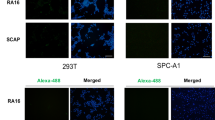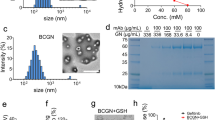Abstract
Nanomedicine era is not far from its realization, but a major concern of targeted delivery still stands tall in its way. Herein we demonstrate the mechanism underlying the anticancer activity of an RNA aptamer (Apt) conjugated to gefitinib-loaded poly (lactic co-glycolic acid) nanoparticles (GNPs). Apt was selected through Cell-SELEX (systemic evolution of ligands by exponential enrichment) process against gefitinib-resistant H1975 lung cancer cells. The selected aptamer exhibited high specificity toward H1975 cells, both qualitatively as well as quantitatively. Software analysis using the MATCH tool predicted Ets1, a proto-oncoprotein, to be the target of the selected aptamer. Interestingly, the localization of identified aptamer varied in descending order of Ets1 expression, wherein maximum localization was observed in H1975 cells than in MDA-MB231, DU-145, H23, H460, A431, A549 and MCF-7 cells, and minimum in L132 cells. Furthermore, Apt-GNP bio-conjugate showed augmented anticancer activity specifically in Ets1-overexpressing cells. In addition, partial depletion of Ets1 in H1975 cells and overexpression of Ets1 in L132 cells reversed the targeting efficacy of the aptamer. Notably, a single intratumoral injection of the Apt-GNP bio-conjugate abrogated the growth of tumor in H1975 xenograft nude mice. Altogether, we present a pioneering platform, involving aptamers, which can be clinically used as a diagnostic marker for metastasis as well as an effective delivery system to escort the pharmaceutical cargo specifically to Ets1-overexpressing highly progressive tumors.
This is a preview of subscription content, access via your institution
Access options
Subscribe to this journal
Receive 50 print issues and online access
$259.00 per year
only $5.18 per issue
Buy this article
- Purchase on Springer Link
- Instant access to full article PDF
Prices may be subject to local taxes which are calculated during checkout













Similar content being viewed by others
References
Meert A-P, Martin B, Delmotte P, Berghmans T, Lafitte J-J, Mascaux C et al. The role of EGF-R expression on patient survival in lung cancer: a systematic review with meta-analysis. Eur Respir J 2002; 20: 975–981.
Hynes NE, Lane HA . ERBB receptors and cancer: the complexity of targeted inhibitors. Nat Rev Cancer 2005; 5: 341–354.
Arteaga CL, Johnson DH . Tyrosine kinase inhibitors-ZD1839 (Iressa). Curr Opin Oncol 2001; 13: 491–498.
Ellington AD, Szostak JW . In vitro selection of RNA molecules that bind specific ligands. Nature 1990; 346: 818–822.
Tuerk C, Gold L . Systematic evolution of ligands by exponential enrichment: RNA ligands to bacteriophage T4 DNA polymerase. Science 1990; 249: 505–510.
Kim Y, Wu Q, Hamerlik P, Hitomi M, Sloan AE, Barnett GH et al. Aptamer identification of brain tumor-initiating cells. Cancer Res 2013; 73: 4923–4936.
Shangguan D, Meng L, Cao ZC, Xiao Z, Fang X, Li Y et al. Identification of liver cancer-specific aptamers using whole live cells. Anal Chem 2008; 80: 721–728.
Van Simaeys D, Löpez-Colön D, Sefah K, Sutphen R, Jimenez E, Tan W . Study of the molecular recognition of aptamers selected through ovarian cancer cell-SELEX. PLoS One 2010; 5: e13770.
Lupold SE, Hicke BJ, Lin Y, Coffey DS . Identification and characterization of nuclease-stabilized RNA molecules that bind human prostate cancer cells via the prostate-specific membrane antigen. Cancer Res 2002; 62: 4029–4033.
Mi J, Liu Y, Rabbani ZN, Yang Z, Urban JH, Sullenger BA et al. In vivo selection of tumor-targeting RNA motifs. Nat Chem Biol 2010; 6: 22–24.
Keefe AD, Pai S, Ellington A . Aptamers as therapeutics. Nat Rev Drug Discov 2010; 9: 537–550.
Kaur J, Tikoo K . p300/CBP dependent hyperacetylation of histone potentiates anticancer activity of gefitinib nanoparticles. Biochim Biophys Acta 2013; 1833: 1028–1040.
Kel AE, Gáβling E, Reuter I, Cheremushkin E, Kel-Margoulis OV, Wingender E . MATCHTM: a tool for searching transcription factor binding sites in DNA sequences. Nucleic Acids Res 2003; 31: 3576–3579.
Sharrocks AD . The ETS-domain transcription factor family. Nat Rev Mol Cell Biol 2001; 2: 827–837.
Sharrocks AD, Brown AL, Ling Y, Yates PR . The ETS-domain transcription factor family. Int J Biochem Cell Biol 1997; 29: 1371–1387.
Li R, Pei H, Watson DK . Regulation of Ets function by protein-protein interactions. Oncogene 2000; 19: 55.
Dassie JP, Hernandez LI, Thomas GS, Long ME, Rockey WM, Howell CA et al. Targeted inhibition of prostate cancer metastases with an RNA aptamer to prostate-specific membrane antigen. Mol Ther 2014; 22: 1910–1922.
Farokhzad OC, Jon S, Khademhosseini A, Tran T-NT, LaVan DA, Langer R . Nanoparticle-aptamer bioconjugates a new approach for targeting prostate cancer cells. Cancer Res 2004; 64: 7668–7672.
Buggy Y, Maguire T, McGreal G, McDermott E, Hill A, O'Higgins N et al. Overexpression of the Ets1 transcription factor in human breast cancer. Br J Cancer 2004; 91: 1308–1315.
Nakayama T, Ito M, Ohtsuru A, Naito S, Sekine I . Expression of the ets-1 proto-oncogene in human colorectal carcinoma. Mod Pathol 2001; 14: 415–422.
Petros RA, DeSimone JM . Strategies in the design of nanoparticles for therapeutic applications. Nat Rev Drug Discov 2010; 9: 615–627.
Davis ME, Shin DM . Nanoparticle therapeutics: an emerging treatment modality for cancer. Nat Rev Drug Discov 2008; 7: 771–782.
Guo K-T, Ziemer G, Paul A, Wendel HP . CELL-SELEX: novel perspectives of aptamer-based therapeutics. Int J Mol Sci 2008; 9: 668–678.
Li N, Nguyen HH, Byrom M, Ellington AD . Inhibition of cell proliferation by an anti-EGFR aptamer. PLoS One 2011; 6: e20299.
Farokhzad OC, Cheng J, Teply BA, Sherifi I, Jon S, Kantoff PW et al. Targeted nanoparticle-aptamer bioconjugates for cancer chemotherapy in vivo. Proc Natl Acad Sci USA 2006; 103: 6315–6320.
Chu TC, Marks JW, Lavery LA, Faulkner S, Rosenblum MG, Ellington AD et al. Aptamer: toxin conjugates that specifically target prostate tumor cells. Cancer Res 2006; 66: 5989–5992.
Valter MM, Hügel A, Huang HJS, Cavenee WK, Wiestler OD, Pietsch T et al. Expression of the Ets1 transcription factor in human astrocytomas is associated with Fms-like tyrosine kinase-1 (Flt-1)/vascular endothelial growth factor receptor-1 synthesis and neoangiogenesis. Cancer Res 1999; 59: 5608–5614.
Sacchi N, De Klein A, Showalter SD, Bigi G, Papas TS . High expression of ets-1 gene in human thymocytes and immature T leukemic cells. Leukemia 1988; 2: 12–18.
Sementchenko VI, Watson DK . Ets target genes: past, present and future. Oncogene 2000; 19: 6533–6549.
Xiao Z, Levy-Nissenbaum E, Alexis F, Lupták A, Teply BA, Chan JM et al. Engineering of targeted nanoparticles for cancer therapy using internalizing aptamers isolated by cell-uptake selection. ACS Nano 2012; 6: 696–704.
Acknowledgements
The intellectual property rights of the above described delivery system comprising of the aptamer-NP bio-conjugate are protected under Indian Patent Office (Indian Patent application no: 1623/DEL/2014).
Author Contributions
JK designed, performed the experiments and analyzed the data. KT designed, supervised and approved the final version of manuscript.
Author information
Authors and Affiliations
Corresponding author
Ethics declarations
Competing interests
The authors declare no conflict of interest.
Additional information
Supplementary Information accompanies this paper on the Oncogene website
Supplementary information
Rights and permissions
About this article
Cite this article
Kaur, J., Tikoo, K. Ets1 identified as a novel molecular target of RNA aptamer selected against metastatic cells for targeted delivery of nano-formulation. Oncogene 34, 5216–5228 (2015). https://doi.org/10.1038/onc.2014.447
Received:
Revised:
Accepted:
Published:
Issue Date:
DOI: https://doi.org/10.1038/onc.2014.447
This article is cited by
-
Development and characterization of fused human arginase I for cancer therapy
Investigational New Drugs (2023)
-
MicroRNA-941 regulates the proliferation of breast cancer cells by altering histone H3 Ser 10 phosphorylation
Scientific Reports (2020)
-
ETS1 regulates Twist1 transcription in a KrasG12D/Lkb1−/− metastatic lung tumor model of non-small cell lung cancer
Clinical & Experimental Metastasis (2018)
-
Directing cellular information flow via CRISPR signal conductors
Nature Methods (2016)



